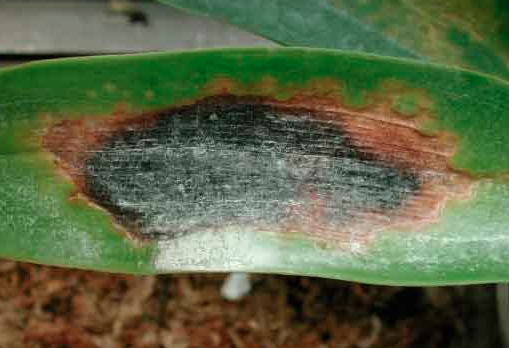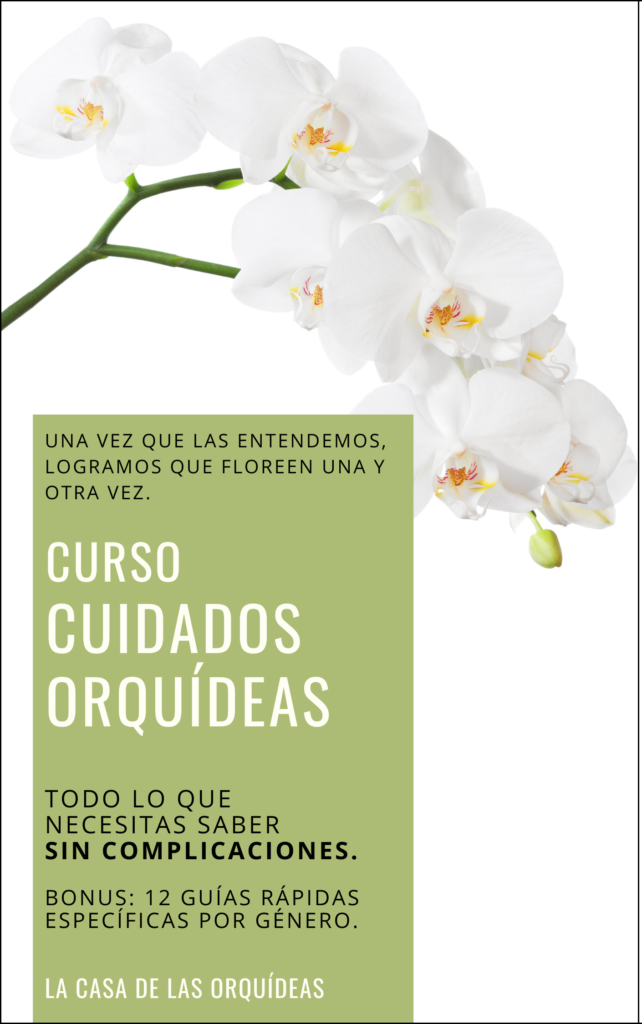+ Spanish
The rainfalls are here with the change of the weather, surprising a lot of us with their early arrival this year!! One may think we are in the middle of the summer since the beginning of May.
These rainfalls bring along a mortal enemy of our orchids, the fungal infections. It’s time to previse and protect all our plants, which will always be better than to try to heal them later. Specially if you’re growing outside.
The fungi that attacks our orchids (without getting into Mycology details) can be divided in two groups: those who spot our leaves (Cercospora y Phyllosticata) and those that provoque rot in our plants (Pythium y Phytophthora). As a preventive measure we should use systemic fungicides and we can find a wide variety of them for each type of fungus. A systemic fungicide, insecticide, miticide… is the chemical that is absorbed by the plant to strengthen their defenses against diseases or pests; they work from the inside out.
We must review our basic care factors and have a healthy growing culture:
– knowledge and routine of our waterings
– ventilation
– humidity
– light
– temperature
– nutrition
Even if we do everything correctly culture wise, there are times when our efforts are not enough and the fungal infections will reach our collections.
Martin Motes, PHD, says in his book “Cultivo de orquídeas en Florida” (translation: “Growing Orchids in Florida”):
“The fungus that spot the leaves are symptomatic to a poor ventilation and lack of the right amount of light, but even with the correct growing culture, we rarely are free of these fungus in the South of Florida. This is almost inevitable because the infection affects a lot of our garden plants. Under the strike of the huge and constant rainfalls during these months, sometimes the slightest problems can grow to epidemic dimensions. The best proven systemic fungicide is thiophanate-methyl (3336 de Cleary, Domain and Fungo) and the most recommended to control the spotting of the leaves. It’s even more effective when combined with mancozeb (Manzate o Dithane M45). There are two pre packed combinations available in the market: Duosan and Tops MZ). Always follow the label’s instructions.
In order to be really effective, the thiophanate-methyl must be applied early in the growing season (right now!!), the after 2 weeks and after that, every 5 or 6 weeks during the rainy season. If you follow this regime to the letter you’ll be able to control almost all fungus that spot the leaves, including the feared Phyllostictina capitalense. The effectiveness of the fungicide will improve with a sticker (spreader sticker) that will help the fungicide stay on the plant throughout the heaviest rains longer.
The soft rot and black of the roots on sympodial orchids and the crown rot on the Vandaceous orchids are caused by two different organisms, Pythium y Phytophthora, but it is very difficult to determine the difference between them. The control of these infections requires different products than the ones used for the infections that spot the leaves. Etridiazole (Truban) has been used for a long time. The amateur grower can easily find it, in combination with thiophanate-methyl (the product recommended for the spotting of the leaves) in the Banrot formulation. Applied the same way as suggested before with the thiophanate-methyl, this formula must be adequate to treat most fungal problems and also to control crown rot. If the problems continue, other two systemic fungicides provide excellent control: Alliete (fosetyl-aluminum) y Subdue 2E (matelaxil).
All chemical products must be applied strictly in the proportions listed in the instructions on the label.”
We think this text from Dr. Martin Motes is very interesting and very well explained. If you live in a tropical zone where your garden is being lashed by rain and your plants are starting to develop fungal infections, you can apply these products to all of them, not only orchids.
In most cases the fungus that spots the leaves, if the spots do not grow, they don’t represent a real threat to your plant other than in an aesthetic way. However, the fungus that cause rot to the root or crown rot are very dangerous and can kill your entire collection. Quoting Dr. Motes again “an ounce of prevention is worthier than a pound of healing”.
We hope you van fin these products in your local markets!! We have some of them (the needed to prepare the combinations mentioned, or the pre packed ones) in our store, under the section Food & Health, in the submenu Disease Control (click on the link to get there). Please make sure to select your Country on the right side of the header to see the products in your language and currency.
check out our store!!
(click on the image)
Bibliografy:
“Cultivo de orquídeas en Florida – Mes por mes”
Martin Motes, PhD
2010, Editorial Redland Press


